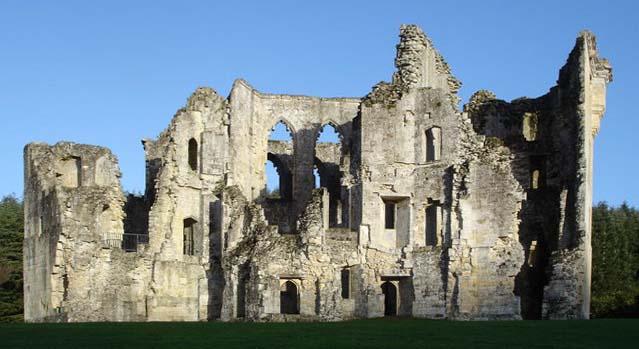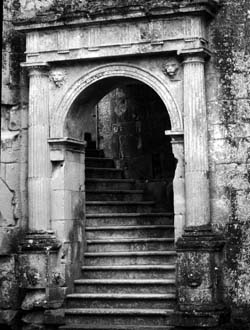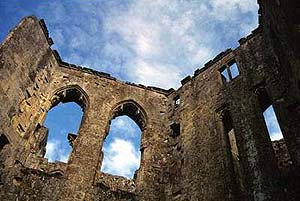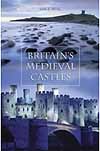Old Wardour - Wiltshire's Hexagonal Castle
by Lise Hull
Now known as Old Wardour Castle, the impressive Arundell home
near Salisbury reflected the status of its owners. Even in ruin,
it remains an imposing sight. Surrounded by a lush expanse of
green grass, the white stone castle dazzles the eyes even on drab
rainy days. Recorded in the Domesday Book of 1086, the manor of
Wardour was modest by most standards, only covering 120 acres of
land. Apparently, the Saxon kings of Wessex had occupied the
small site, but by the time of the Norman conquest, it had been
granted to Wilton Abbey, a Benedictine nunnery about ten miles
away. Eventually, ownership passed by right of marriage to John
and Maud Lovel, who owned vast estates throughout England,
including Minster Lovell, their ancestral home.

In 1393, John, the 5th Lord Lovel, acquired a license to
crenellate and began construction of his new castle at Wardour.
Taking its inspiration from contemporary French design currently
in vogue, Lovel's master architect, probably William of Wynford,
created a splendid hexagonal castle which combined beauty and
comfort with defensive might. Fronted by a drawbridge and
enclosed by a dry ditch, Wardour Castle would have posed quite a
threat to attackers. Among its defensive features were a series
of portcullises, massive walls, and corner turrets crowned with
battlements. Around the perimeter, a substantial curtain wall
provided added security for the keep-like stronghold.
The castle's four stories surrounded a central courtyard, where
the well was located. Several doorways led from the courtyard to
the upper levels. An enormous kitchen block filled the ground
floor and much of the first floor with several huge fireplaces,
bread ovens, walk-in cupboards, sinks, and drains leading to
storage cisterns in the basement. The pantry and buttery stood
near by, poised to serve the guests in the ornate great hall,
which spanned the area immediately above the main entranceway.
Spiral staircases allowed access to the uppermost levels, which
held the private apartments and, possibly, the chapel, before
their destruction in the Civil War.
 Wardour Castle remained in the hands of
the Lovel family until 1461, when Edward IV ordered the seizure
of the Lovel estates in retaliation for John Lovel's support of
the Lancastrian cause during the Wars of the Roses. This John
Lovel was the great-grandson of the John Lovel who built the
castle 70 years earlier. In 1547, Sir Thomas Arundell, from
Lanherne in Cornwall, purchased Wardour Castle, and it remained
the property of the Arundells until its demise after the Civil
War. Wardour Castle remained in the hands of
the Lovel family until 1461, when Edward IV ordered the seizure
of the Lovel estates in retaliation for John Lovel's support of
the Lancastrian cause during the Wars of the Roses. This John
Lovel was the great-grandson of the John Lovel who built the
castle 70 years earlier. In 1547, Sir Thomas Arundell, from
Lanherne in Cornwall, purchased Wardour Castle, and it remained
the property of the Arundells until its demise after the Civil
War.
When Sir Matthew Arundell altered the castle into a more
comfortable home in 1570, he weakened the structure's defensive
capabilities by removing the towers that flanked the main
entrance. In their place, however, Arundell added one of the
castle's finest features, a curious set of decorated shell-headed
seats, and adorned the facade with a bust of Christ and the
family's coat of arms. Above the entryway he also embedded an
inscription, which emphasized his role in the rebuilding of the
castle and his hereditary ties to the Arundells at Lanherne. It
also included the date, 1578. Besides embellishing the main
entrance, Matthew remodeled the great hall, added a new
minstrel's gallery, realigned the doorways, added more
fireplaces, and replaced most of the windows.
Almost 75 years later, Wardour Castle and its occupants
threatened the stability of the emerging Parliamentary government
despite its weakened defenses. In late April 1643, a force of
some 1,300 men led by Sir Edward Hungerford and General Edmund
Ludlow besieged the castle, in an effort to reduce Lord
Arundell's influence with the king. With her husband engaged
elsewhere and despite having only 25 troops and some household
staff to help defend her home from the Parliamentarians, Lady
Blanche Arundell refused to surrender. For eight days, she
withstood the onslaught and the attackers' small cannons
inflicted only minor damage to some windows and a chimneypiece.
Finally, Hungerford ordered his men to plant gunpowder mines
underneath the castle walls. They laid one in the service tunnel
that led to the cellars under the eastern side of the main
entrance and another in the base of a latrine chute that drained
the private apartments. Incredibly, the building resisted the
explosions, but the garrison persuaded Lady Blanche to surrender
on May 2nd.
Ludlow and his Parliamentarian troops promptly moved into the
still very livable castle. In December of 1643, Henry, the new
3rd Lord and heir to the Arundell estate, led a Royalist assault
on Wardour, determined to reoccupy his family home. Unlike the
siege earlier in the year, this battle raged for several months.
Pounding by cannons broke windows and gouged the walls, but the
castle remained strong until mid-March, 1644, when Arundell
ordered his men to lay gunpowder mines. Yet, unlike the assault
the previous May, this time the Royalist mines devastated the
castle.
 Apparently, one of Ludlow's men unwittingly tossed a
match into the tunnel where a mine lay hidden. The resulting
explosion ripped a gaping wound in the rear of the building, and
destroyed the upper floors of the castle. General Ludlow, asleep
at the time, was forced to single-handedly defend what was left
of his bedchamber until his men could reach him. After four days,
the threat of more mining and their increasing hunger forced the
Parliamentarians to admit defeat. Henry, Lord Arundell, had
indeed regained control of his castle, but had inadvertently
destroyed it in the fray! Apparently, one of Ludlow's men unwittingly tossed a
match into the tunnel where a mine lay hidden. The resulting
explosion ripped a gaping wound in the rear of the building, and
destroyed the upper floors of the castle. General Ludlow, asleep
at the time, was forced to single-handedly defend what was left
of his bedchamber until his men could reach him. After four days,
the threat of more mining and their increasing hunger forced the
Parliamentarians to admit defeat. Henry, Lord Arundell, had
indeed regained control of his castle, but had inadvertently
destroyed it in the fray!
After the Parliamentarians finally gained control of the
government, not only did they execute Charles I, but they also
seized the Arundell estate at Wardour. The family moved to
Hampshire, but later in the century they began a new building
program at Wardour. Rather than rebuilding the castle, they opted
to remodel the outbuildings and, for a time, lived in the
renovated stable block. Life was fairly comfortable, for they not
only made use of a brewhouse and a banqueting house but also had
a fine bath house, an orchard, and lavish gardens.
During the 18th century, the Arundells built New Wardour, which
is visible in the distance. They hired the famous landscape
architect, Lancelot "Capability" Brown, to transform
the grounds and several lakes and a new banqueting house soon
appeared in the shadow of the ruins. In the 19th century, Old
Wardour Castle became a popular destination for visitors who
enjoyed the romanticism of the ruins, and in 1944 it was taken
over by the State when the last Lord Arundell died.
Today, Old Wardour Castle remains a stunning ruin. At the
northern end of the property, two unusual features complete the
lingering impression of a romantic era long since past. An 18th
century stone grotto serves as a nesting place for birds, while
the remains of a prehistoric stone circle hide in the woodland
behind the ticket booth. During the 1990s, the castle was the
setting for the movie Robin Hood, Prince of Thieves,
starring Kevin Costner.
To reach Old Wardour Castle from Salisbury, head west on the A30
about 12 miles. At the minor road at Ansty, turn northward toward
Tisbury. At Tisbury, watch for signs to the castle, which is open
daily throughout the year, for a small fee.
Related Articles:
- Salisbury: Designed to In-Spire, by Moira Allen
- https://www.timetravel-britain.com/articles/towns/salisbury.shtml
- Timeline: Salisbury, by Darcy Lewis
- https://www.timetravel-britain.com/articles/towns/saltime.shtml
- Old Sarum: A Layer-Cake of History, by Moira Allen
- https://www.timetravel-britain.com/articles/castles/sarum.shtml
More Information:
We regret that we no longer have the resources to maintain up-to-date links and/or hours and pricing details for the various sites and attractions listed on this website. For more information about the location(s) listed above, please use your favorite search engine or visit Wikipedia.
 |
Lise Hull is a recognized authority on British castles and heritage, with a Master of Arts degree in Heritage Studies from the University of Wales, Aberystwyth, as well as a Master of Public Affairs degree, specializing in Historic Preservation, from Indiana University. She is the author of several of books on Britain, including Britain's Medieval Castles (Praeger: 2005), Great Castles of Britain and Ireland (New Holland: 2005) and Castles and Bishops' Palaces of Pembrokeshire (Logaston Press, 2005). Her work has appeared in numerous publications, including Military History Quarterly, Military History, Renaissance Magazine, Family Tree Magazine and Everton's Family History and Genealogical Helper magazines; she is also a regular contributor to Faerie Magazine. Visit her website at http://www.castles-of-britain.com. Hull also writes TimeTravel-Britain.com's Finding Your Roots column.
|
Article © 2007 Lise Hull
Photos courtesy of Wikipedia.org
|
